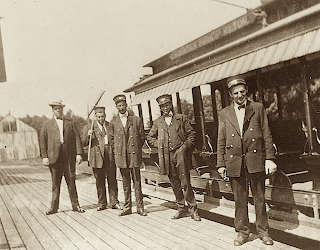Early Years Of The Holyoke Street Railway
Employees of the Holyoke Street Railway pose for a group picture in front of the newly constructed car barn at Canal & Bridge Streets in 1908. (Photo courtesy of the Seminole Bailey Collection)
Holyoke Street Railway car barn circa 1915. A view of repair shop showing car hoists and overhead crane and concrete covered-trusses. (Seminole Bailey Archive)
The Holyoke Street Railway was founded in 1884 by a number of Holyoke businessmen including William Chase, C. Fayette Smith and H.M. Smith. The railway was granted a charter to operate in both Holyoke and South Hadley.
Originally the Railway operated as a horse drawn trolley system between the two towns, with two cars and a rotating team of five horses operating a two mile route between Main Street in Holyoke to South Hadley Falls.
Horse drawn trolley heading south on Canal Street toward Lyman Street circa 1885. (Photo courtesy of the Holyoke History Room)
By 1886 the Railway had quadrupled to fifty-six horses and fifteen cars with a line that extended from Dwight, High and Appleton Streets to Beech, Pleasant and Lincoln Streets. The railway's expansion caught the eye of William Stiles Loomis, who at the time owned interest in the Holyoke Transcript. Loomis sold his interests in the Transcript and in 1888 purchased the Holyoke Street Railway and further expanded the line throughout the city.
As the railway entered the 1890s, further expansion continued in the city and also included lines into neighboring Chicopee. It was also at this time the Railway converted from horse drawn to electrification, which caused many investors to be skeptical about this new technology that it would result in many setbacks, but as with change, many were also reluctant to it, and this was probably the biggest reason many were against it.
Furthermore, it eliminated many jobs especially for those involved with the care of the horses being replaced.
The railway's biggest success came when Loomis purchased land on Mt. Tom from Westfield lumber businessman Roswell Fairfield. This parcel of land included the summit of the mountain and land down near to banks of the Connecticut River.
Cedar Knob. William Stiles Loomis summer home on the left. (Photo courtesy of the Seminole Bailey Collection)
In 1895 Loomis sold 395 acres of this property to the Holyoke Street Railway for $50,000 who created a trolley park that became Mountain Park. Loomis set aside a few acres of land on the east side of Cedar Knob for his private summer residence, "The Crag". Two years later, in 1897, a subsidiary company, Mt. Tom Railroad was formed and construction of a mile long rail that ran up to the Mt. Tom summit from the base of Mountain Park was built.
Construction of the rail bed to the summit of Mt. Tom late 1890s. (Photo courtesy of the Seminole Bailey Collection)
The crew of the Mt. Tom Railroad on the boardwalk of Lower Station in 1927. (Photo courtesy of the Seminole Bailey Collection)
The above photos show a trolley passing through the rock cut section of the rail bed between Mountain Park and Lower Station.
Once this rail line was in operation, work began on the first Summit House on the peak of Mt. Tom. the house lasted only four years when it was destroyed by fire and a new, more lavish structure was built. This Summit House would meet the same fate and burn down in 1929. This was the same year that ownership of Mountain Park changed hands to Loomis' assistant Louis Pellissier.
Trolley heading south on Northampton Street from Mountain Park to South Holyoke 1930s.
The trolley service to Mountain Park would prosper up until the mid 1930s when changing times forced the Railway to phase out it's trolley service which also led to the decision to close the Mt. Tom Railroad line to the Summit House.
The Holyoke Street Railway would operate Mountain Park under Pellissier until the end of 1952 when the park was sold to John Collins, who did an extensive renovation of the park that flourished until 1987 when again, changing times marked the end of Mt. Park as an amusement center. The park is now functions as a music venue operated by area businessman Eric Suher.
A Holyoke Street Railway trolley waits for passengers at Mountain Park to take them back downtown. This photo was taken in 1935, near the end of the trolley era in Holyoke.
By 1936 the trolley service was nearing it's end. Here is a photo of trolley 114 heading north on Newton Street in South Hadley in late summer of that year. (Seminole Bailey Archive)
Holyoke Street Railway Elmwood/West Dwight bus. City Hall early 1940s.
As for the Holyoke Street Railway, after the trolley years, it's fleet was converted to diesel buses and operated by the Pellissier family until 1987 when it shut down. A major factor being the loss of the lucrative contract with the Holyoke School Department and labor disputes with it's workforce.















No comments:
Post a Comment